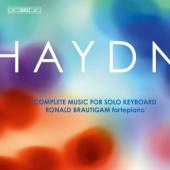Haydn: Complete Music For Solo Keyboard
Label: BIS Catalog: CD1731/33 Format: CD Ronald Brautigam, fortepianoJoseph Haydn:Sonatas Nos 1–20 and 28–62; Capriccio „Acht Sauschneider müssen seyn“ in G major, Hob.XVII:1; Arietta con 12 variazioni in E flat major, Hob.XVII:3; Arietta con 12 variazioni in A major, Hob.XVII:2; Fantasia in C major, Hob.XVII:4; 6 leichte Variationen in C major, Hob.XVII:5; Andante con variazioni in F minor, Hob.XVII:6; Adagio in F major, Hob.XVII:9; 20 Variationen in G major, Hob.XVII:2; Andante con variazioni in D major, Hob.XVII:7; Andantino (Allegretto) con variazioni in A major, Hob.XVII:8; Allegretto in G major, Hob.XVII:10; Andante con variazioni in B flat major, Hob.XVII:12; Aria con variazioni in C major, Hob.XVII:15; Adagio in G major, Hob.XV/22II; Allegretto con variazioni in A major, Hob.XVII?A3; Allegretto in G major, Hob.III:41IV; Variationen über die Hymne „Gott erhalte Franz, den Kaiser“ in G major, Hob.III:77II; Il Maestro e lo Scolare in F major, Hob.XVIIa/1; 12 Menuette, Hob.IX:11; 12 Deutsche Tänze, Hob.IX:12; 12 Menuette, Hob.IX:3; 12 Menuette, Hob.IX:8; 2 Märsche (for Sir Henry Harpur), Hob.VIII:1; Marsch, Hob.VIII:3/3bis; Kontretanz, Hob.XXXI:c:17b; Die Sieben letzten Worte unseres Erlösers am Kreuze Two systems of numbering currently exist for Haydn’s sonatas: one by Karl Päsler (1920), adopted in 1957 inpart XVI of the Hoboken catalogue (52 sonatas plus eight lost ones) and another, now more frequently used, from the 1963–66 edition by Christa Landon (62 sonatas plus seven lost ones). These works and the authentic miscellaneous pieces for solo keyboard can be divided chronologically into four groups of varying importance; together they constitute a body of work of consistent high quality and great variety.
 Price: $86.98 Price: $86.98 |












